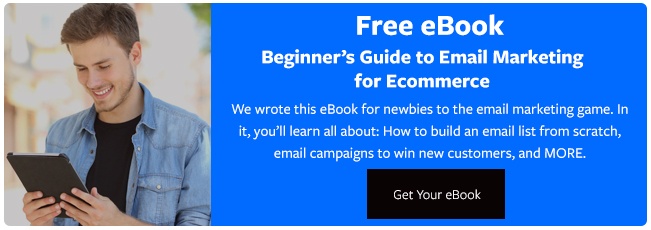
If you’re the owner of an online store, one of the best ways to build and maintain relationships with your customers is through email marketing. However, determining the optimal email frequency remains a challenge.
Not sending emails could cause your customers to forget you, while sending too many could lead to being blacklisted. Finding the right balance between maintaining your reputation and driving sales and/or engagement is key.
Efficiently optimizing your email marketing approach requires finding the right cadence. With the right balance, you can drive engagement, nurture customer relationships, and ultimately boost your conversion rates.
Finding that sweet spot requires an in-depth familiarity with your target audience's habits and preferences. Consider what they buy, how engaged they are, and the items or services they favor. For example, during busy seasons, an apparel business may benefit from sending out more emails than a niche merchant, who might choose to take a slower approach.
Let’s dive deeper into how often your business should send emails to your eCommerce customers.
How To Strike the Optimal Email Frequency
To establish your email frequency, you need to align with customer behavior, perception, and preferences. Bombarding subscribers with excessive emails can lead to disengagement and fatigue.
Conversely, infrequent messaging can cause your brand to slip from customers’ minds.
Consider your target market’s buying patterns, engagement levels, and the items or services you offer to create a personalized email cadence. Segmenting your list based on your customers’ preferences and activities can lead to more conversions and stronger connections.
Key Considerations for Emailers
To optimize the effectiveness of your email frequency, it’s critical to understand your consumers’ preferences and behaviors. Analyze their purchasing patterns, engagement levels, and the unique attributes of the products or services you provide.
During periods of heightened demand, apparel brands have the opportunity to optimize their email communication strategies. In contrast, specialty stores may opt for a more measured approach.
When segmenting your email list, consider several crucial factors related to audience engagement. By taking into account demographic information, previous purchases, and browsing patterns, you can tailor messaging and frequency to successfully connect with different consumer segments.
Quality and Relevance of Content
The quality and relevance of your email content play a crucial role in determining how often you should contact your customers. High-quality, personalized, and valuable content often justifies a higher email frequency, as subscribers are more likely to engage with messages that add value to their lives.
Conversely, generic or irrelevant content can lead to disengagement, even with a lower email cadence.
Industry Standards and Best Practices
When determining the optimal frequency of email communication, consider consumer preferences and content quality. However, it is also prudent to reference industry standards and best practices.
Analyzing successful eCommerce brands within your sector can provide invaluable insights into effective email marketing strategies, including benchmarks for optimal frequency. It is crucial to tailor these strategies to your particular audience and to consistently monitor and adjust your methods based on success indicators.
Determining the optimal email frequency is an ongoing endeavor that requires awareness of market developments, consumer preferences, and industry dynamics.
Concentrating on customer-centric strategies, generating valuable content, and maintaining a flexible approach can significantly increase the effectiveness of your eCommerce email marketing campaigns.
Strategies for Determining Email Frequency
Finding the perfect balance for email frequency is a nuanced endeavor that requires a thorough understanding of your audience, their preferences, and their habits.
1. Assess your current email cadence.
Start by evaluating your current email cadence (if any). Are you on the right track, or do you need to adjust your strategy?
If your business is new, this is your chance to set goals that benefit both you and your customers. Most small eCommerce brands begin with a monthly newsletter, which is an effective way to keep your brand top of mind without overwhelming subscribers.
Once you’ve established a baseline, gradually increase the frequency — from once a month to twice a month or even weekly — only if you have genuinely valuable information to share.
Some companies find success with more frequent communication, sending daily emails with deals, updates, or new offers. A/B testing is essential to determine the right frequency for your audience. In this format, also consider optimizing subject lines and delivering information that enhances the overall customer experience.
2. Monitor your metrics consistently.
Many factors determine whether an email or campaign is successful. Key metrics include open rates, click-through rates (CTRs), and other conversion data.
Leveraging these metrics can help fine-tune your efforts. Top email newsletter platforms like Mailchimp are equipped with analytics tools to capture this information.
Delivering relevant content to your customers requires streamlined segmentation so that personalization feels authentic. Understand your customers’ pain points and address them rather than sending out irrelevant mailers—your metrics will be a good indicator of effectiveness.
This can be achieved by utilizing demographic data, browsing history, and purchase history. New subscribers may appreciate welcome emails with discounts, while loyal customers might respond better to exclusive updates or tailored offers.
3. Keep an eye on industry leaders and competitors.
Knowing what the competition is doing and seeking inspiration from their strategies can also be beneficial. You can reverse-engineer some of their successful campaigns to gain insights.
Remember that finding the optimal email frequency is not a static target; it requires adaptation and refinement. What may work now might need significant adjustments in a year, so continual tweaks are essential for success.
Once you identify the right cadence that balances revenue and engagement, you can transition to optimizing campaigns for greater impact.
4. Focus on small gestures.
Sometimes, small gestures can make your brand stand out, particularly in email marketing. It’s important to remain relevant, but also to make customers feel valued. Regular offers combined with avenues for customer communication can foster loyalty.
By consistently utilizing data, showing empathy, and experimenting, you can enhance your campaigns with thoughtful gestures. A customer-centric mindset is pivotal for unlocking sustainable growth.
Monitoring Customer Engagement
Finding the right balance for email frequency can be tricky. If you send too few emails, customers may forget your brand, allowing competitors to take over. Conversely, overwhelming them with messages can lead to unsubscribes and possibly spam complaints.
There isn’t a one-size-fits-all answer; the best frequency depends on your goals, the type of product or service you offer, and what your customers desire. You may need to experiment and make adjustments.
1. Define your goals.
First, decide what you want your emails to achieve. Are they promotional, informative, or designed to build brand loyalty? Different goals may warrant different frequencies.
For instance, one-time emails like welcome messages differ from daily content updates or weekly newsletters. Holiday campaigns or event invitations can be sent at irregular intervals.
2. Track competitors’ email habits.
Monitor your competitors’ email strategies and key metrics such as open rates, click-through rates, and unsubscribe rates. Among these, conversion rates are crucial. If you’re using email marketing to nurture leads, your frequency should be balanced to keep subscribers engaged without feeling overwhelmed.
Identify where your subscribers are in the eCommerce sales funnel and base your plan on how frequency impacts conversion rates.
3. Segment your audience.
It’s important to divide your audience into groups for personalized, relevant content. Adjust messaging frequency based on past sales, browsing habits, and demographics. A welcome series might be effective for new subscribers, while special deals might be more appealing to regular customers.
Be mindful of how often you send emails. Sending too many can result in being marked as spam, which can cause your messages to be overlooked.
Finding the optimal time to send eCommerce marketing emails is also important for maximizing opens and sales. For many, the best time is during regular business hours, from 6 a.m. to 12 p.m.
However, consider experimenting with unconventional send times. Fewer emails are sent late at night (6 p.m. to 12 a.m.), but the average order value tends to be higher. Your emails might also stand out during busy periods, like early afternoons or early evenings when inboxes are less crowded.
It’s interesting to note that sending emails on weekends can lead to higher open rates. With fewer emails in circulation, your message is more likely to stand out. Ensure your messages are optimized for mobile devices, as this can yield impressive results during non-traditional work hours.
Test and Learn
Testing and optimizing through A/B experiments across segmented lists is critical for success.
While research offers valuable insights, remember that your specific audience may have unique preferences and behaviors. Keep your email campaigns fresh by regularly adjusting send times and monitoring open and click metrics closely. Be prepared to adapt your strategy based on the latest insights.
Here are ideal benchmarks to strive for:
- Average open rates typically range from 17.1% to 27.3%.
- The average click-through rate is around 2.3%.
- A strong click-to-open rate is between 6% to 17%.
Regardless of research findings, your results may vary. Discovering the most effective approach for your business involves gathering available data and testing various hypotheses.
Successfully reach your target audience by sending messages to specific lists at various times throughout the week. Gain valuable insights by tracking the effectiveness of each campaign and consider adjusting your strategy to include weekends based on observed outcomes.
Discovering the Perfect Email Frequency for Your eCommerce Business
Finding the perfect balance is crucial for successful eCommerce email marketing.
Excessive messaging may lead to overflowing inboxes, causing interest to wane and customers to unsubscribe. Conversely, insufficient emails risk forgetting your brand and allowing competitors to take over. Discover tried-and-true methods to achieve lasting success:
- Avoid overwhelming your customers with excessive email communication, as this can lead to fatigue and disinterest. The frequency of your emails should vary based on your products and target audience.
- It is generally recommended to start with a slow and steady pace before gradually increasing frequency as you gauge engagement levels.
- Focus on creating value during the content gathering and drafting process. This may involve offering exclusive deals, providing personalized recommendations, or sharing informative and engaging content.
- Keep an eye out for exciting promotions or events that could warrant more frequent communication.
- Segment your audience by considering factors such as purchase history, browsing behavior, and demographics. Tailor experiences to cater to specific tastes and interests, building relationships with email subscribers.
- Prioritize ongoing testing and optimization. Experiment with send times, subject lines, and content to identify what resonates best with your evolving audience.
By adhering to these guidelines and maintaining a customer-centric approach, you can navigate the intricate world of eCommerce email marketing, nurturing lasting relationships and driving sustainable growth.
To Summarize
Ultimately, finding the perfect balance for how often to send emails to your eCommerce customers requires a combination of creativity and data-driven analysis. It involves understanding your audience’s preferences, delivering value with every message, and continuously refining your approach through experimentation.
While industry best practices can provide a helpful starting point, true success lies in treating your email marketing strategy as an ever-evolving journey.
Keep in mind that the goal is not just to send out emails, but to foster long-term connections based on trust, relevance, and a sincere commitment to enhancing the customer experience.





Leave a reply or comment below